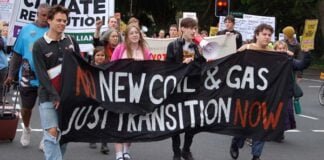A standing room only crowd of around 700 people gathered at Melbourne University in July for the launch of Beyond Zero Emissions’ (BZE) Zero Carbon Australia Stationary Energy Plan. The turnout shows the popularity of their approach to climate solutions, which is to look at achieving the emissions reductions necessary to halt climate change, while maintaining living standards and social equity.
Their plan comprehensively shows that a combination of 60 per cent solar thermal, and 40 per cent wind power, with a small amount of biomass generation for backup, together with energy efficiency measures could provide all of Australia’s energy needs. Solar thermal power is the main component—with molten salt heat storage, it can provide baseload electricity day and night.
The transition plan would directly create 80,000 jobs from installation of renewable energy at the peak of construction, and 45,000 continuing jobs in operations and maintenance. BZE has another plan in preparation that will deal with transport.
The plan would cost $370 billion over a decade, less than 4 per cent of GDP, but would provide savings of $1.6 trillion by 2040 because of cuts to fossil fuel expenditure. BZE argue that the $370 billion could be borrowed and paid back over 40 years. That would make the cost about $9 billion per year (before any interest payments). Coincidentally $9 billion per year is an estimate of what the federal government spends annually on fossil fuel subsidies.
BZE say they are agnostic on how the plan should be funded, and whether through private or public investment. Nonetheless the plan is a serious challenge to the logic of the market.
The private sector, even with government subsidies, cannot possibly implement a plan of this scale within a decade—it would require government planning and investment. The plan would also require upgrade and connection of Australia’s three main electricity grid regions, which would undermine the idea of separate electricity markets.
Government built all the coal-fired power generators in Australia, and Australia’s only large-scale renewable energy plant, the Snowy Hydro scheme.
Grassroots movement needed
However the BZE launch seemed aimed at winning “respectable” opinion, rather than putting a case for building a movement or the public investment that could deliver their plan.
Speakers at the launch included corporate representatives from renewable energy companies, the Grattan Institute (a Labor-leaning think tank) and academics. There were no activists (apart from BZE) or trade union speakers. Some of the speakers seemed hesitant to give the BZE plan their full support.
There was much confusion about how the BZE plan could be implemented. John Daley from the Grattan Institute argued for a high carbon tax of above $80 per tonne, saying a level any lower would not work. He didn’t explain the impact this would have on electricity prices, and whether implementing it would be politically possible. Lane Crockett from Pacific Hydro and Allan Atchison from ACS Cobra supported business subsidies like feed-in tariffs. No speaker supported or even talked about the possibility of government investment and planning.
Having the renewable energy companies seemed a conscious strategy to get industry on side, hoping they will pressure government. This can only pull the movement in a conservative direction.
As if to show this, a question from the floor asked why the renewable industry couldn’t successfully lobby the government like the mining companies had. Such an approach draws away from mobilising people in the streets by looking to “powerful people” to take action on our behalf, and will alienate the movement from trade unionists. Many workers are rightfully distrustful of their own bosses, and having businessmen on the platform sends a signal that such meetings are not welcome to workers’ involvement.
Renewable energy companies are still corporations whose fundamental reason for existing is to make money, not to save the planet. Individual renewables companies have an interest in locking other companies out of the industry and so delaying the transition in order to secure their own profits, and have no interest in direct government investment, which would undermine them.
It was a shame that the launch was not used to let people know how they can get involved in the climate movement, or as a springboard for protests and actions supporting the plan. Nonetheless the BZE approach of looking at what actually needs to change in the real economy is the right one.
We know that 100 per cent renewable energy is technically possible, the big question is how do we build a movement that can deliver it.
By Chris Breen





